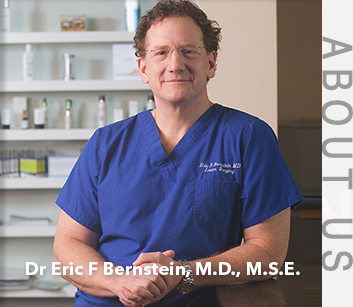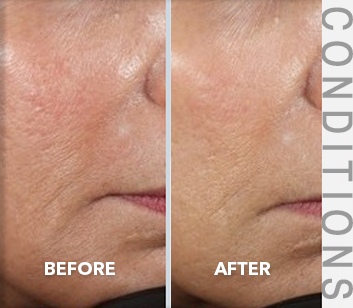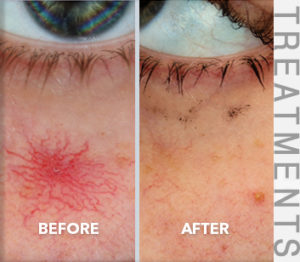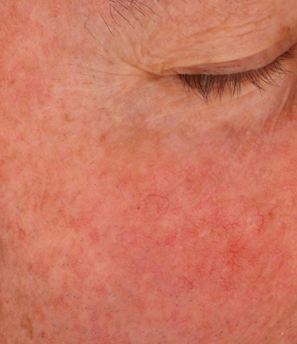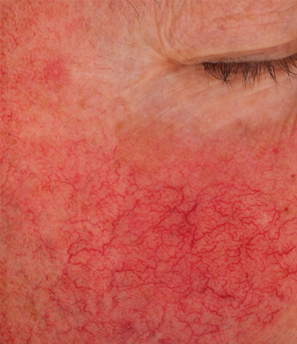Conditions
Rosacea
Results of Treatment
Generally, a series of 2-4 treatments are required to dramatically improve rosacea.
About Rosacea
Rosacea is an extremely common condition affecting from 1-20% of the population, depending upon the population being looked at. In the US it is estimated that between 14 and 16 million people have rosacea, and if mild forms of facial redness and flushing are added, this number is probably much greater. Rosacea is characterized by flushing and blushing due to the appearance of veins in sun-exposed areas of the face, often accompanied by pimples, and most commonly by generalized redness. Rosacea most commonly affects light-skinned people beginning in their late 20 to 30s, although it can appear for the first time earlier or later, depending upon one’s genetic pre-disposition to make facial veins in response to sunlight, and the amount of sun-exposure a person receives throughout their lifetime. However, any skin type can be affected by rosacea. The cause of rosacea is sun-exposure in folks who are genetically pre-disposed to develop EXTRA facial veins in response to sunlight. These extra veins fill up more rapidly than normal facial veins, so people with rosacea flush and blush very easily in response to many stimuli such as: hot and cold, exercise, alcohol consumption, hot drinks…basically, LIFE.
The sun is THE CAUSE of the extra veins, and this fact is obvious when looking at the distribution of facial veins in folks with rosacea. The veins and redness appear in sun-exposed areas, and the more sun-exposed an area generally is (like the nose), the more that veins will occur in that area. People with rosacea may have flushing and redness only, or develop pimples as well, which can often become severe. The flushing people with rosacea experience is usually in response to stimuli such as hot and cold, hot beverages like coffee or tea, wine or other alcohol-containing beverages, exercise, emotions, and other stimuli. Some doctors will recommend avoiding all these triggers which is pretty much impossible. Removing these extra veins with lasers is really the only treatment that addresses the vascular component of rosacea in a permanent way.
The areas affected by rosacea most often are the cheeks, nose, chin, and central forehead. Rosacea can also rarely affect the eyes, causing stinging and irritation. Treatment of the pimple component of rosacea requires topical medications such as adapalene and metronidazole, and sometimes oral antibiotics such as doxycycline. The vascular lasers can do wonders to improve rosacea by removing the large spider veins and generalized redness associated with this condition. Generally, a series of 2-4 treatments is required to dramatically improve rosacea, although most people see a significant improvement after only a single treatment. Studies have shown that laser treatment can even help reduce the bumps and pimples associated with rosacea, in addition to dramatically reducing the redness and flushing that characterize rosacea.
To answer your specific questions or schedule a consultation, call Dr Bernstein today of 610-645-5551.
Did you know?
Dr. Bernstein was the first physician in the world to use the V-Beam Perfecta® and V-Beam Prima® lasers and one of the first in the U.S. to acquire the Excel-V® laser has published numerous peer-reviewed articles on treating conditions with these lasers including Rosacea and has published extensively on their use.
Rosacea/Facial Redness FAQs
WHAT CAUSES ROSACEA AND FACIAL REDNESS?
The main cause of rosacea and facial redness is the sun. We can see this right away by looking at the areas of the face affected by redness the most: the cheeks, nose, chin and central forehead. These are the most sun-exposed parts of our face. Also, the driver’s side if most often affected in drivers, while the passenger side is most often affected in passengers, and the opposite sides are affected in countries like England and Australia where people drive on the opposite side of the car.
DOES DRINKING ALCOHOL OR EXERCISE CAUSE ROSACEA?
Numerous triggers cause the veins we people with rosacea have acquired from the sun to fill up and flare including: wine and other alcohol, exercise, hot and cold temperatures, emotion, hot coffee or tea and others. By this list you can see that avoiding these triggers is impossible, and won’t affect the overall severity of rosacea, but only cause temporary flares of the condition which is there all the time.
HOW MANY TREATMENTS DO I NEED?
Generally people require 2-4 treatments to get rosacea under control. More can be required in more severe rosacea or with certain types of rosacea, but 2 treatments is generally a minimum for sustained results.
HOW FAR APART ARE TREATMENTS
Generally treatments are administered 4-6 weeks apart but longer intervals are fine.
WILL I NEED TOUCH UP TREATMENTS?
If you never go outside again, you won’t require any more treatments. What this means is that the more sun-protection you get, the less treatments you will need. People often return for a single treatment at 1, 2, 5 or more years after a series of treatments depending upon how many new veins they make in the sun.
WHAT CAN I DO TO PREVENT ROSACEA?
The best defense against rosacea is continued sun-protection. People often think they are doing a good job at sun protection by wearing sunscreen at the beach every time they go. We need an SPF 30 or higher sunscreen every day, and more water-resistant sunscreens when going swimming. UV-blocking CLEAR window film on your car is key for sun-protection as most of our time outside (unless you live in a major city like New York) is time spent in our cars.
WHAT IS THE KERATOSIS PILARIS FORM OF ROSACEA (KPRF)?
Keratosis pilars (KP) is a common skin condition where people experience scaly bumps, often with redness, characteristically on the backs of the arms. When KP occurs on the face it gets the fancy name of Keratosis Pilaris Rubra Facei (KPRF), which just means scaly bumps in the follicles with redness on the face. KPRF appears as a pebbly surface among a background of redness on the face. The reason this is important is that KPRF responds somewhat differently to laser and can take more treatments and unique laser settings to treat. Laser treatment is still the most effective way to treat KPRF.
ARE THERE ANY OTHER BENEFITS TO TREATING MY ROSACEA?
Lasers used to treat rosacea and facial veins also benefit the skin by improving fine lines and wrinkles, skin texture and enlarged pores via the inflammation that follows laser treatment. Also, the extra veins we acquire from the sun don’t belong there, and skin is healthier without them.
HOW WILL I LOOK AFTER LASER TREATMENT?
Most people just look a pink and puffy following laser treatment, and sometimes people with a lot of facial redness can get some bruising. Swelling and redness normally lasts for a few days but can sometimes last longer, bruising can stick around for a week or 2.
WHAT DO I NEED TO DO FOR AFTER CARE?
Following laser treatment, most people discontinue AHAs, like glycolic acid, and retinoids, like Retin-A, for a few days. Mild cleansers and moisturizers can be used after most laser treatments. Cool compresses a few times a day can reduce swelling.

